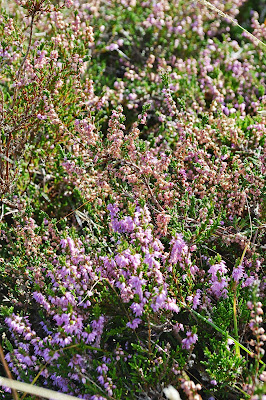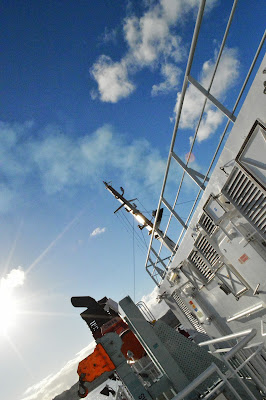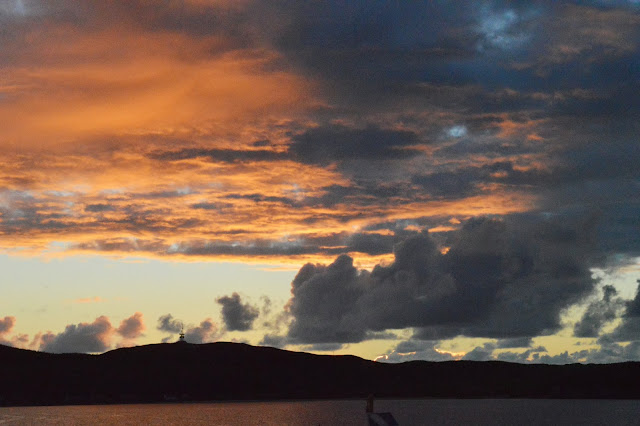The day started, much like most other days of our trip, bright and sunny. We packed up the flat and dragged all of our luggage to the same coffee shop we were at a couple of days earlier. As folks started arriving for the tour, it was clear that we were going to be an interesting group. First off, there were seven guys together: six Swedes and a German. I think they were kind of bummed to see that there would be others on the tour with them, but by the end of the trip we were all quite friendly (except for one guy who never smiled). All told there were fourteen of us on the tour: the aforementioned group of seven, another couple from Sweden, a couple from Melbourne, a younger guy from Holland, us, and our driver Simon.
When it came time to leave, while everyone was setting up our luggage in the back of the bus, I hopped on and got the best seats. I can be devious like that when I want to. Alan actually had the best seat of the tour since he had extra leg room and could see out the front window. As awesome as our tour was, the bus left something to be desired in the comfort department. It certainly wasn't meant for fat asses like myself, that's for sure.
Making our way out of Edinburgh, Simon had us introduce ourselves and talk a little bit about when we first started drinking whisky, specifically single malts. For us, the experience began after reading 99 Drams of Whiskey: The Accidental Hedonist's Quest for the Perfect Shot and the History of the Drink and wanting to get our hands on a bottle of Laphroaig. (If you're at all curious to learn about what makes whisky so special, I strongly recommend this book. In addition to it being educational, it's also funny and written in a very personable way.)
After about an hour or so, we made our first stop of the day: Deanston Distillery for a tour, a tasting, and what were the best scones we had on the entire trip.
Deanston Distillery started life in 1785 as a cotton mill designed by Sir Richard Arkwright, and remained as such for 180 years until it was transformed into a distillery in 1966. The constant supply of pure water from the River Teith contributed to the decision to turn the mill into a distillery and Deanston is now the only distillery in Scotland to be self-sufficient in electricity, with power generated by an on-site hydro-energy facility. Deanston sits in the Highland single malt region of Scotland and produces whisky which is handmade by ten local craftsmen, un-chill filtered, natural colour and bottled at a strength of 46.3% ABV.
Have you heard the saying, "Armed to the teeth?" Well, teeth is actually Teith in that saying. You see, the Highlanders, being a society made up of warriors, were always armed. The lowlanders were not. To keep the "violent" highlanders from coming down into the lowlands and wreaking havoc, before they could venture into the area, they had to drop off their weapons. The demarkation for where this happened was the River Teith. So, essentially, they were armed to the Teith. (Or so the story goes.)
The tour and tasting at Deanston was a really great experience, and afterward we were all in high spirits. As we left we learned that we'd be driving up through Oban, which had me really excited because Oban 14 is among my favorite un-peated single malts around.
The Oban distillery sits in the town of the same name and overlooks the harbour and the sea at Scotland’s western coast. The Oban distillery was founded in 1793 by Hugh and John Stevenson on the site of an old brewery. The distillery dominates the town, despite being rather small and its aesthetics are rather imperial. The pair of stills has a capacity of just 670,000 litres per annum and almost all of this is matured and bottled as single malt Scotch whisky.
Before stopping in Oban however, we made another stop at a beautiful area called the Falls of Lora. The weather here was perfectly beautiful, and the scenery was stunning.
The Falls of Lora is a tidal race which forms at the mouth of Loch Etive when a particularly high tide runs out from the loch. They form white water rapids for two to five days either side of the spring tides. The falls are generated when the water level in the Firth of Lorn (i.e. the open sea) drops below the level of the water in Loch Etive as the tide goes out. As the seawater in Loch Etive pours out through the narrow mouth of the loch, it passes over a rocky shelf which causes the rapids to form. As the tide rises again there is a period of slack water when the levels are the same on either side. However due to the narrow entrance to the Loch, the tide rises more quickly than the water can flow into the Loch. Thus there is still considerable turbulence at high tide caused by flow into the Loch. Thus, unlike most situations where slack water is at high and low tides, in the case of the Falls of Lora slack water occurs when the levels on either side are the same, not when the tidal change is at its least. As a result the tidal range is much greater on the coast than it is inside the loch. A 3 metres (9.8 ft) range at Oban may produce only a 1.3 metres (4.3 ft) at Bonawe on the loch shore.
It was only a couple of minutes from there to Oban, where we had a two hour break in the day for lunch and site-seeing.
The site where Oban now stands has been used by humans since at least mesolithic times, as evidenced by archaeological remains of cave dwellers found in the town. Just outside the town stands Dunollie Castle, on a site that overlooks the main entrance to the bay and has been fortified since the 7th century. Prior to the 19th century, the town itself supported very few households, sustaining only minor fishing, trading, shipbuilding and quarrying industries, and a few hardy tourists.
The modern town of Oban grew up around the distillery which was founded there in 1794, and the town was raised to a burgh of barony in 1811 by royal charter. Sir Walter Scott visited the area in 1814, the year in which he published his poem The Lord of the Isles, and interest in the poem brought many new visitors to the town. The arrival of the railways in the 1880s brought further prosperity, revitalising local industry and giving new energy to tourism. Shortly thereafter McCaig's Tower, a folly and prominent local landmark, was constructed, as well as the ill-fated Oban Hydro.
During World War II, Oban was used by Merchant and Royal Navy ships and was an important base in the Battle of the Atlantic. The Royal Navy had a signal station near Ganavan, and an anti-submarine indicator loop station which detected any surface or submarine vessels between Oban, Mull and Lismore. There was a controlled minefield in the Sound of Kerrera which was operated from a building near the caravan site at Gallanach. There was also a Royal Air Force flying boat base at Ganavan and on Kerrera, and an airfield at North Connel built by the Royal Air Force. A Sector Operations Room was built near the airfield, and after the war this was extended to become the Royal Observer Corps Group HQ.
Oban was also important during the Cold War because the first Transatlantic Telephone Cable (TAT-1) came ashore at Gallanach Bay. This carried the Hot Line between the US and USSR presidents.
Since the 1950s the principal industry has remained tourism, though the town is also an important ferry port, acting as the hub for ferries to many of the Hebrides.
The town is a true gem. Utterly adorable and beautiful. The perfect seaside village. They also have amazingly delicious seafood.
If we were to ever live in Scotland (what, it could happen!), I would definitely plan to spend a couple of days in Oban, taking in more of the town and the surrounding areas, including catching the ferry to the Isle of Mull.
From Oban, we hit the road with our ferry to Islay as the final destination. But first we stopped at Kilmartin Glen. I would have loved to have had a couple of hours to explore Kilmartin, but because we were on a schedule, we had about 30 minutes to wander around the kirkyard and explore some of the historic items.
Kilmartin Glen has one of the most important concentrations of Neolithic and Bronze Age remains in Scotland. There are more than 350 ancient monuments within a six mile radius of the village, with 150 of them being prehistoric. Monuments include standing stones, a henge monument, numerous cists, and a "linear cemetery" comprising five burial cairns. Several of these, as well as many natural rocks, are decorated with cup and ring marks. The remains of the fortress of the Scots at Dunadd, a royal centre of Dal Riata, are located to the south of the glen, on the edge of the Moine Mhòr or Great Moss.
Some people have described Kilmartin Glen as better than Stonehenge, and without the crowds.
Our last stop before jumping on the ferry was a small seaside village called Tarbert, on Loch Fyne. Apparently there are several towns named Tarbert in Scotland, because it describes an small strip of land between two bodies of water. Our guide advised us never to enter "Tarbert" into a GPS system and expect to get to the right one. I don't really have a whole lot to say about Tarbert, other than the fact that Alan loves calling it a bonny wee village. All of the seaside villages we stopped in or saw were just so perfectly picturesque.
And then it was time - our ferry to Islay! First, I was so, so, so excited because we were finally going to our main destination. But also because I really love ferry rides. See, I'm excited.
After a two-hour ferry ride - that included stunning scenery, a rain storm, a miraculous sunset, lots of wind, and a whole lot of excitement - we finally approached Islay and Port Ellen.
Islay is the fifth-largest Scottish island and the seventh-largest island surrounding Great Britain, with a total area of almost 620 square kilometres (239 sq mi). There is ample evidence of the prehistoric settlement of Islay and the first written reference may have come in the 1st century AD. The island had become part of the Gaelic Kingdom of Dál Riata during the Early Middle Ages before being absorbed into the Norse Kingdom of the Isles. The later medieval period marked a "cultural high point" with the transfer of the Hebrides to the Kingdom of Scotland and the emergence of the Clan Donald Lordship of the Isles, originally centred at Finlaggan. During the 17th century the Clan Donald star waned, but improvements to agriculture and transport led to a rising population, which peaked in the mid-19th century. This was followed by substantial forced displacements and declining resident numbers. Today, it has over 3,000 inhabitants and the main commercial activities are agriculture, malt whisky distillation and tourism. The island has a long history of religious observance and Scottish Gaelic is spoken by about a quarter of the population. Its landscapes have been celebrated through various art forms and there is a growing interest in renewable energy. Islay is home to many bird species such as the wintering populations of Greenland White-fronted and Barnacle Goose, and is a popular destination throughout the year for birdwatchers. The climate is mild and ameliorated by the Gulf Stream.
So, why Islay? The whisky of course.
Islay is a centre of "whisky tourism", and hosts a "Festival of Malt and Music" known as Fèis Ìle each year at the end of May, with events and tastings celebrating the cultural heritage of the island. The whiskies of the distilleries along the southeastern coast of the island, Laphroaig, Lagavulin, and Ardbeg, have a smoky character derived from peat, considered a central characteristic of the Islay malts, and ascribed both to the water from which the whisky is made and to the peating levels of the barley. Many describe this as a “medicinal” flavour. They also possess notes of iodine, seaweed and salt. Caol Ila, on the northern side of the island, across from Jura, also produces a strongly peated whisky.The other distilleries on the island make whisky in a variety of styles. Bunnahabhain and Bruichladdich make much lighter whiskies which are generally lightly peated, though Bruichladdich also produces several heavily peated products. Bowmore produces a whisky which is well balanced, using a medium-strong peating level (25ppm) but also using sherry-cask maturation. The newest distillery, Kilchoman, started production in late 2005. In location it is unlike the other seven distilleries, which are all by the sea.
From Port Ellen we had a drive across the island - through peat bogs and fields of heather in bloom - to our lodgings for the duration of our time on the island, Bowmore House. Once I booked our tour, I did some social media investigation and found out that the owner of Bowmore House, Andrew, was active on Instagram and began following and interacting with him. By the time we arrived around 8 p.m. that night, it felt like we were finally meeting up with old friends. I think a few of our new Swedish friends were a bit surprised to see that Andrew knew me by name and that we had talked before our trip. When he said something about following our journey online, one of them turned to Alan and said, "did you know this?" Um yes, yes he did. Very distrustful of the social media, those older Swedes.
The reception our whole group received at Bowmore House couldn't have been more lovely. Right away we were greeted warmly, like treasured guests, and were fed a bounty of local seafood, including langostines and oysters.
We were then shown to each of our rooms, and I have to say, I was incredibly pleased with our space. It was huge and the bathroom was large and lovely. It was the perfect b&b accommodation, and everything we could have hoped for. Oh, and our view? Yeah, stunning as well.
That night we made our way down the street to the pub at the Lochside Hotel, which was an unusually strange experience. Immediately next door to the hotel is a pub called Duffies. We walked in that door and were greeted by some gregarious local Scotsman. I couldn't understand half of what they said, but they were teasing us about wanting to hang out with them. We went over to the other side of the pub to order some whisky but the bartender was nowhere to be found. A guy from a group that was also there went behind the bar to serve us, confusing the heck out of me. What was also confusing was the whisky menu. I'm talking pages upon pages of whisky, and we had no idea what we wanted. I forget what Alan ordered, but I went with the special, a 25 year old Caol Ila. OMG. So smooth and luxurious. Heading back to the Bowmore House, we fell asleep in our giant king size bed and slept the sleep of the extremely happy.
Edited to add: In putting together this re-cap, one of the things we've realized is that it's hard to put into words the feelings we had during this trip. So much was looking out across the horizon, and experiencing a deep sense of peace or wonderment. For many on this tour, the trip to Islay was a pilgrimage of sorts, the culmination of a lifelong desire to visit the place you have a deep and abiding love for without ever having set eyes on it before. The water of life, the peat that imparts the smoke, the salt air that adds the brine. Every little part of Islay is in those drams, and by going there, you're stepping foot in a place that's as special as Champagne, or Bordeaux, or Napa Valley. A place that only a select few can truly understand, a place that gets into your blood. Standing on the deck of the ferry the excitement was palpable. Jorgen and I were like kids on Christmas morning as we came upon our first view of the distilleries from the water. Jorgen was literally bouncing for the last half hour of the ferry ride. You have never seen a man happier to be going somewhere than he was in that moment. And that excitement and wonder was infectious; I was of course extremely excited, but in bearing witness to the fulfillment of this dream of his, the happiness and euphoria overcame me as well. My excitement was that much greater for being in the presence of his excitement. I don't know if I have the words to adequately describe it to you so that you can know how it felt, or understand the emotions, but imagine there was something that you'd wanted with your whole soul, or imagine there was a place in the world that you knew to your core without ever having been there. And then it's within your sight, and you're stepping off a boat onto the land that has nourished you. You breathe the briny, ocean air. You smell the peat wafting over you. You feel the wind against your face. You taste it, with all of your senses. That, for me, is Islay.


























































































